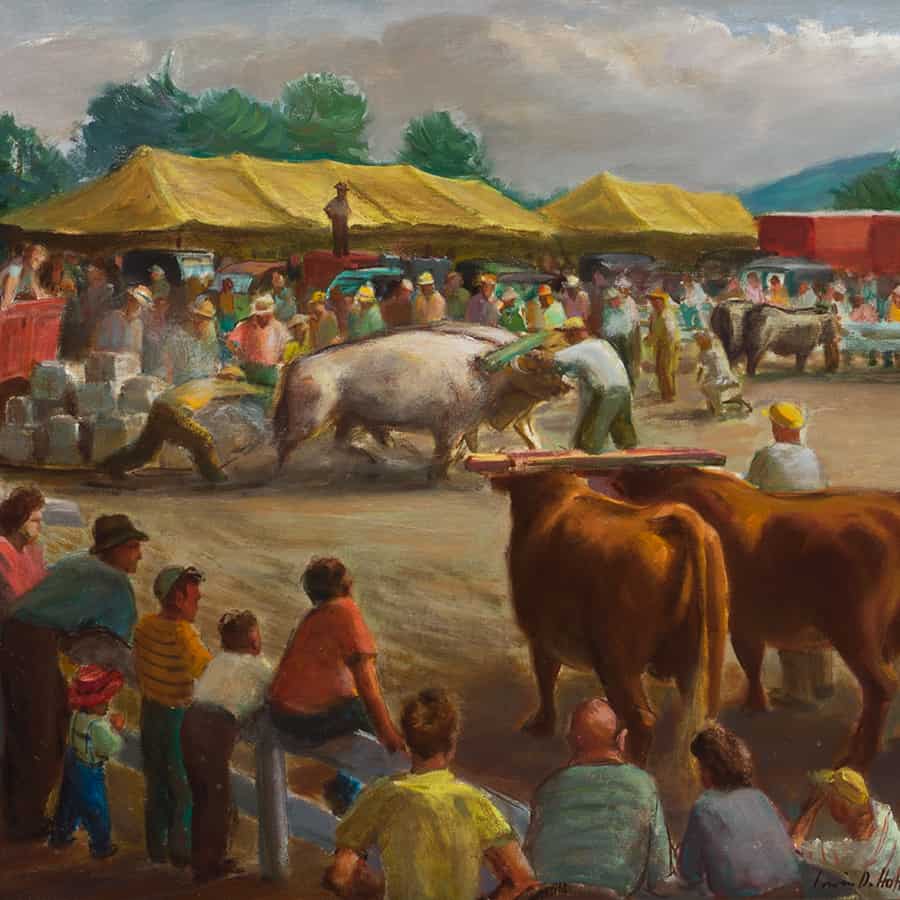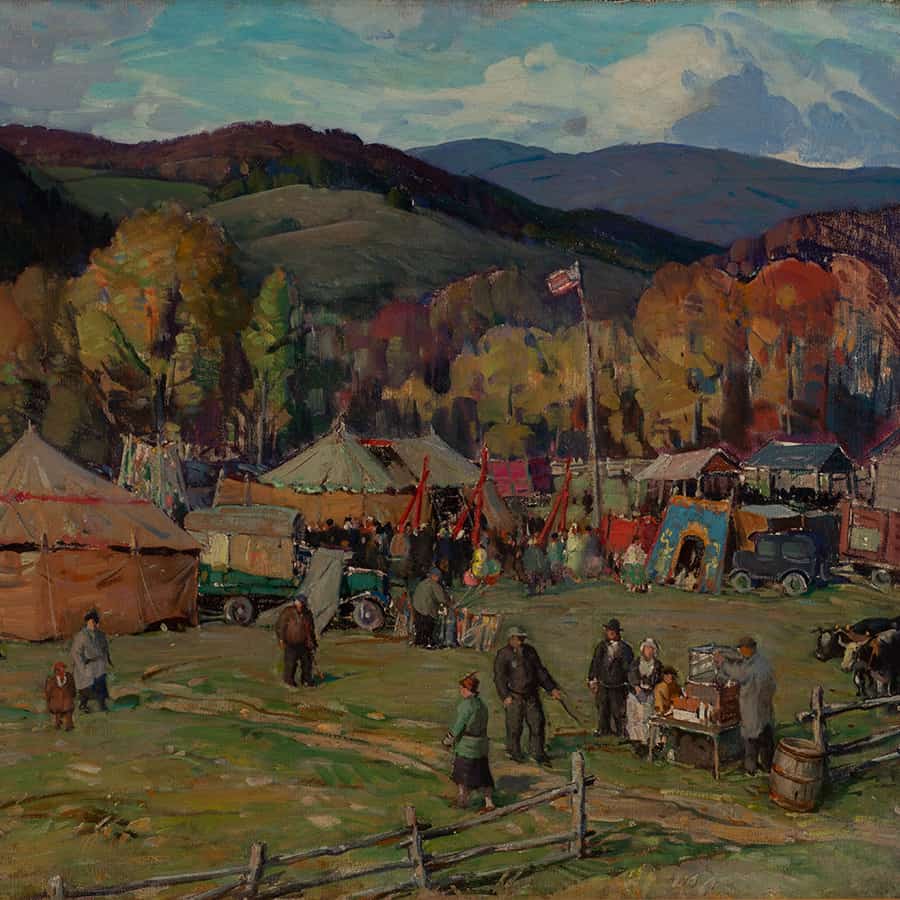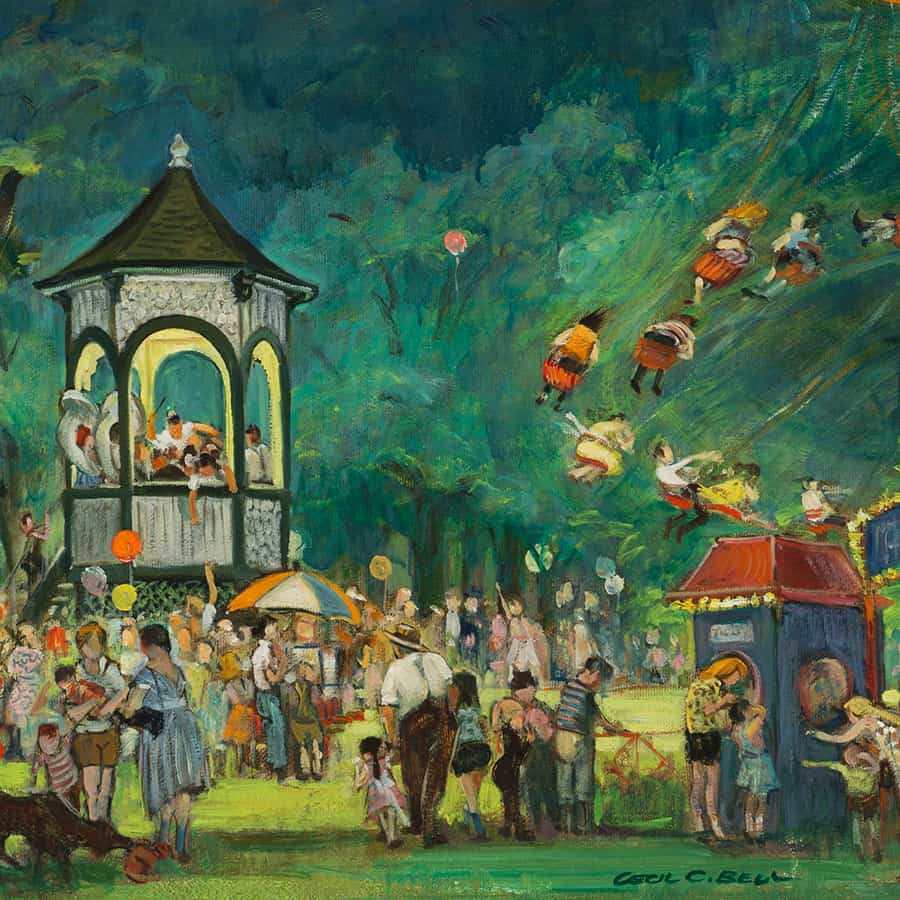Country Fairs
Few things in Vermont have been as important to Vermonters as the annual agricultural fairs. Although there may have been late summer events on a small scale before the 1830s, by the ’40s and ’50s the end-of-harvest-time fair was already an established event, organized yearly by local agricultural associations and later granges.
Vermont’s two biggest fairs nowadays are the Champlain Valley Exposition in Essex Junction and the Vermont State Fair in Rutland; however, most of the promotion for these extravaganzas is aimed at attracting tourists – there is scant reference to activities honoring Vermont’s farmers. It is still possible to find a few small and hyper-local Ag fairs in Vermont.
Excerpt from the book For the Love of Vermont: The Lyman Orton Collection

Ox Pull, Hartland Fair, c. 1945
Oil on Canvas | 24 x 30 in.
Irwin Hoffman (1901-1989)
Only a farmer can fully appreciate that working oxen and horses are structurally different and not necessarily interchangeable: Oxen are strongest in their neck muscles and will pull any load to the maximum limit of their ability, whereas the strength of a team of horses comes from their chests.
It is truly a sight to see when driver handles a pair of two thousand-pound oxen with little more than his or her voice and a couple of one-syllable words. Drivers use the same commands whether the oxen are working the fields or competing.
Irwin Hoffman’s Vermont home and studio were in Cavendish; and he otherwise worked in New York City. Hoffman, who also made and played stringed instruments, came out of the Boston Museum School of Fine Arts. For time was one of the Works Progress Administration (WPA) artists. His work is in the permanent collections of a long and impressive list of major museums and institutions across the country.

Country Fair, c.1947
Oil on Canvas | 25 x 30 in.
Aldro Hibbard (1886–1972)
This painting was featured in a 1947 Maxwell House coffee advertisement. A recent addition to The Orton Collection, this highly detailed scene by Aldro Hibbard is the Bondville Fair. The Bondville Fair has been operating annually since 1797, making it the oldest country fair in Vermont. Hibbard lived not far from the fairgrounds in nearby Jamaica.
Bondville is a part of the town of Winhall. From the fair’s archives, we learn what it was like in the old days:
It moved to its present location in the 20s, when Floral Hall was built. The Dance/Crafts Hall was added in the 30s, and other facilities through the 1980s. The newest structures are the sugar house (1999) and the schoolhouse (2000).
Life was hard for families on the Vermont mountain farms pre-WWII, so you can imagine how people looked forward to the annual Bondville Fair. It brought in a Ferris wheel, a merry-go-round, square dancing, games of chance, a horse pull, agricultural and handcraft exhibits.
In fact, the Bondville Fair was known state-wide as a pretty wild affair. During Prohibition homemade hard cider of a lethal potency was passed around freely.

Carnival at Royalton, Vermont, 1965
Oil on Canvas Board | 24 x 36 in.
Cecil Crosley Bell (1906–1970)
Beginning his art career as freelance illustrator, Cecil Crosley Bell lived and worked in New York City, while also spending some thirty summers painting in and around Stockbridge, Vermont. Around the time Bell painted this scene, the town had nearly fourteen hundred full-time residents, but the summer people and folks from the smaller villages all around Royalton would have come to the carnival for a good time, too.
Lyman Orton comments:
Bell explored all the different aspects of life in Vermont. It is as if he couldn’t get enough of what this place was all about. The Royalton carnival was about fifteen miles from the cabin where he lived, not very far, and he may have been to village carnivals like this one many times.
